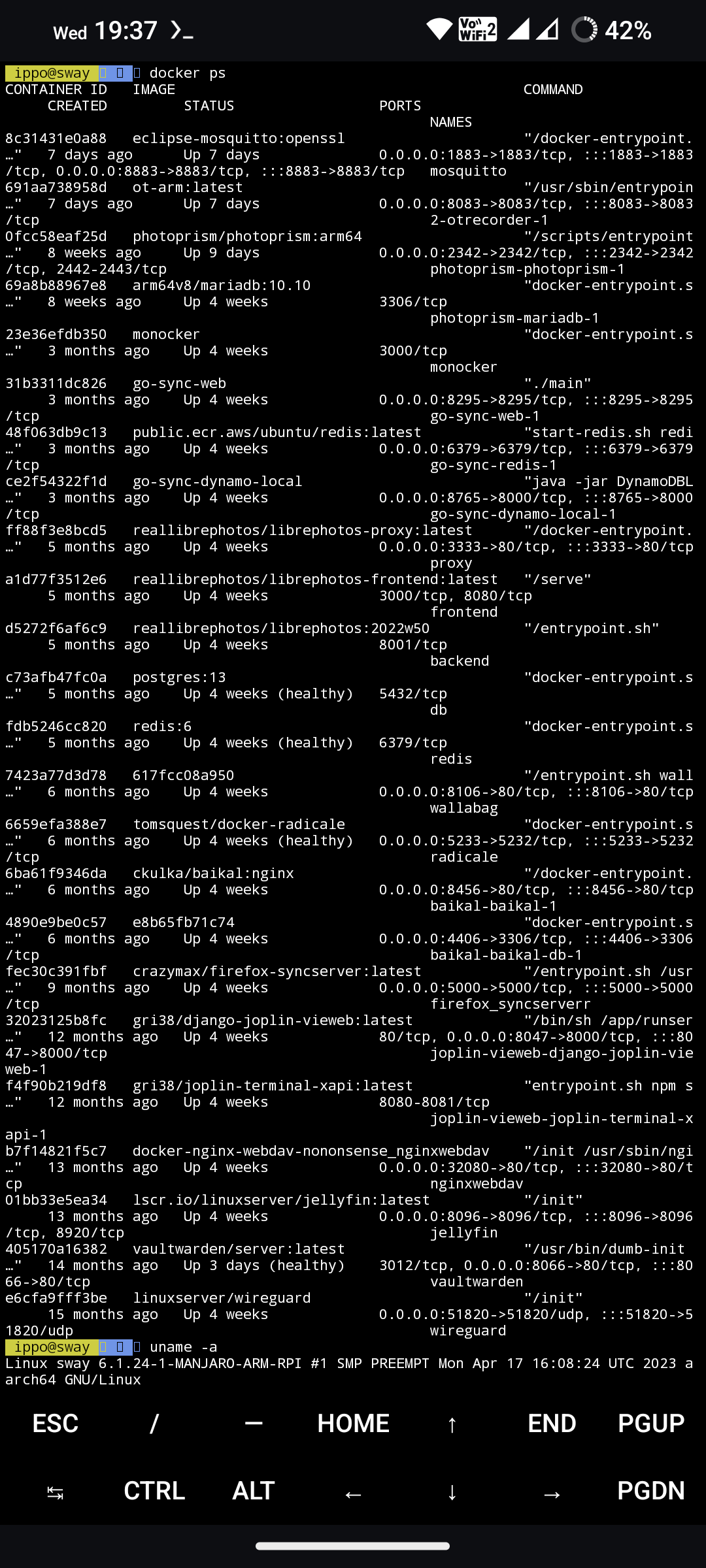For those of you who use Raspberry Pi’s in your home environment, I’m curious as to what you use them for. What applications are you running on them? Do you have your Pi’s setup in a cluster?
I own a raspberry pi 4. Every time I try to use it, I spend half my time trying to fix the stuttery/non responsive UI by fucking with the compistor and such. And then I give up.
I eventually got a new gaming PC and turned my old one into a Linux server, and haven’t really touched my Raspberry Pi since.
I’ll give you $5 for it!
RPI4/400 is perfectly capable as a little home server. All it needs is a good SD card.
Owntracks,photoprism,monocker,brave go m-sync,libre photos,wallabag,radicals e,Baikal,Firefox sync,Joplin web,webdav server,jellyfin,vaultwarden,wireguard

Get an eMMC module ($10) for the Pi or buy something similar with one built-in. Much faster and more reliable.
I have a Pi4 running octoprint, pi-hole and some of my own containers.
The rest I run on a Hetzner VM.
Not much love here for the Pi Zero W. I love them for being so flipping cute. I have a couple I use when I am learning a new system admin tool or service and I need to be able to let it run undisturbed to observe stability and function.
Lately I am learning MQTT so am using one as a broker to manage some homemade smart devices.
If I can ever find one in stock, i want a couple of Zero 2 for similar projects that would benefit from the extra oomph.
I have a Zero with a macropad attached. Key presses are then sent to Home Assistant through MQTT. The zero is perfect for it, small and low power.
Still wondering what to actually do with my Zero 2.
I have one pi (rpi 4b) that I still use. I have it in an Argon One V2 case for the daughter board that lets me boot from an M.2 SATA SSD. I got tired of the corrupted SD cards. It’s actually reliable now.
Anyway, I mainly only use it because in the event of a power outage, as soon as power is restored, it automatically turns on. If I’m not home, I can SSH back into my network and send a WoL packet to my actual server to turn it back on.
The pi also runs:
- Scrypted so I can view my ring cameras in the Apple Home app and so I get the “someone is at the door” notifications on my Apple TV
- Pi-Hole
- Pi-VPN
I used to run everything with Pis, but then got a x86 USFF to improve Nextcloud performance.
With the energy price madness last year in Europe, I moved most things to cloud VPSs.
One Pi is still running Home Assistant, hooked to my heating/ventilation unit via RS485/modbus.
I had a ZFS backup server with 2 HDDs hooked up over USB to a Pi 8GB. That is just way too unreliable for anything serious, I think I now have a lot of corrupted files in the backups. Looking into getting some Synology unit for that.
For anything serious that requires file storage, I’d steer clear from USB or SD cards. After getting used to SATA performance, it’s hard to go back anyways. I’d really like to use the Pis, but family photo backups turning gray due to bitflips is unacceptable.
They are a great entrypoint to self-hosting and the Linux world though!
The first one is a Kodi player.
The second one was originally intended for RetroPi, but now it’s a mp3 player running MPD, and connected to my sleep headphones.
I have a pi 3 running my primary instance of Adguard Home, a pi 4 I don’t know yet what to do with, and a Pi B that has RISCOS on it for fun. Seriously, if you ever just want to poke around a unique OS, download the official RISCOS image in the Raspberry Pi imager. Any UK folks reading this know what I’m talking about. But as an American I’d never heard of it and it’s just friggin’ neat!
RP4 running Home Assistant. Running HA in a docker container is harder than running it as the OS on a Pi4. Running HA is how I get into this, i kept trying to put more crap into HA as addons before realizing i should set up a proper server.
I assembled a handful of temp/humidity sensors (that are actually running on Wemos D1 minis).
One Pi Zero 2W runs NodeRed to control a few lights in the house. Another used to run Octoprint until it recently stopped responding. I haven’t gotten around to troubleshooting it yet.
The only one I have running atm is for Klipper/Moonraker/Mainsail for my 3D printers.
Otherwise I find them so slow to work with that I don’t really like using them, just something like an
apt upgradecan take several minutes or more.I have a Raspberry pi 1b that runs adguard home and a VPN server
I wanted to reuse one for octoprint, but it turned out to be unreliable. So I switched to my NUC instead.
I have the feeking that those SD cards just don’t perform well and wear out more easily, and I really use good ones.
For RPi the two major causes of issues (in my experience) are low spec power supplies and low spec SD-cards.
Power supplies drop voltage when the loads gets too high, which is especially pronounced with high power USB devices like external harddrives.
SD-cards tend to get worn out or give write errors after enough writes. Class 10 SD cards are recommended for both speed and longevity. And ideally try to avoid write intensive stuff on the SD card
Forget SD cards for Raspberry Pis - boot from an SSD in a USB enclosure, they have better longevity than SD cards.
Acronyms, initialisms, abbreviations, contractions, and other phrases which expand to something larger, that I’ve seen in this thread:
Fewer Letters More Letters DNS Domain Name Service/System HA Home Assistant automation software ~ High Availability HTTP Hypertext Transfer Protocol, the Web IP Internet Protocol MQTT Message Queue Telemetry Transport point-to-point networking NAS Network-Attached Storage NUC Next Unit of Computing brand of Intel small computers PiHole Network-wide ad-blocker (DNS sinkhole) Plex Brand of media server package RPi Raspberry Pi brand of SBC SATA Serial AT Attachment interface for mass storage SBC Single-Board Computer SSD Solid State Drive mass storage SSH Secure Shell for remote terminal access VPN Virtual Private Network VPS Virtual Private Server (opposed to shared hosting) nginx Popular HTTP server
[Thread #170 for this sub, first seen 27th Sep 2023, 16:05] [FAQ] [Full list] [Contact] [Source code]
I’m using a pi4 8gb as my server, with a pi4 2gb as backup in case the first one dies. It’s a very classic server, running postfix/courier-imap for mails, lighttpd for web, bind9 for dns, ergo for irc, sqlite3 for databases. I also use fail2ban for IDS and cron to run tons of various task. All of that is hosted on a Gentoo linux OS.
The one thing I don’t want to use is docker. I love docker for development or for deploying the main app at work, but it makes managing updates a nightmare for handling multiple services on my server (most your containers probably contain vulnerable software due to lack of system updates), and it eats resources needlessly. Then again, it’s made possible because I avoid the big webapps that usually need it.








